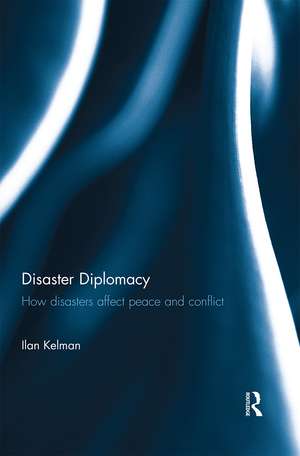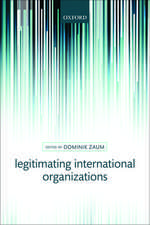Disaster Diplomacy: How Disasters Affect Peace and Conflict
Autor Ilan Kelmanen Limba Engleză Paperback – 30 sep 2020
This book examines how and why disaster-related activities do and do not create peace and reduce conflict. Disaster-related activities refer to actions before a disaster such as prevention and mitigation along with actions after a disaster such as emergency response, humanitarian relief, and reconstruction. This volume investigates disaster diplomacy case studies from around the world, in a variety of political and disaster circumstances, from earthquakes in Greece and Turkey affecting these neighbours’ bilateral relations to volcanoes and typhoons influencing intra-state conflict in the Philippines. Dictatorships are amongst the case studies, such as Cuba and Burma, along with democracies such as the USA and India. No evidence is found to suggest that disaster diplomacy is a prominent factor in conflict resolution. Instead, disaster-related activities often influence peace processes in the short-term—over weeks and months—provided that a non-disaster-related basis already existed for the reconciliation. That could be secret negotiations between the warring parties or strong trade or cultural links. Over the long-term, disaster-related influences disappear, succumbing to factors such as a leadership change, the usual patterns of political enmity, or belief that an historical grievance should take precedence over disaster-related bonds.
This is the first book on disaster diplomacy. Disaster-politics interactions have been studied for decades, but usually from a specific political framing, covering a specific geographical area, or from a specific disaster framing. As well, plenty of quantitative work has been completed, yet the data limitations are rarely admitted openly or thoroughly analysed. Few publications bring together the topics of disasters and politics in terms of a disaster diplomacy framework, yielding a grounded, qualitative, scientific point of view on the topic.
| Toate formatele și edițiile | Preț | Express |
|---|---|---|
| Paperback (1) | 428.31 lei 6-8 săpt. | |
| Taylor & Francis – 30 sep 2020 | 428.31 lei 6-8 săpt. | |
| Hardback (1) | 1108.56 lei 6-8 săpt. | |
| Taylor & Francis – 31 aug 2011 | 1108.56 lei 6-8 săpt. |
Preț: 428.31 lei
Nou
Puncte Express: 642
Preț estimativ în valută:
81.97€ • 85.26$ • 67.67£
81.97€ • 85.26$ • 67.67£
Carte tipărită la comandă
Livrare economică 14-28 aprilie
Preluare comenzi: 021 569.72.76
Specificații
ISBN-13: 9780367669645
ISBN-10: 0367669641
Pagini: 182
Dimensiuni: 156 x 234 x 10 mm
Greutate: 0.27 kg
Ediția:1
Editura: Taylor & Francis
Colecția Routledge
Locul publicării:Oxford, United Kingdom
ISBN-10: 0367669641
Pagini: 182
Dimensiuni: 156 x 234 x 10 mm
Greutate: 0.27 kg
Ediția:1
Editura: Taylor & Francis
Colecția Routledge
Locul publicării:Oxford, United Kingdom
Public țintă
Postgraduate and ProfessionalCuprins
1. The Origins of Disaster Diplomacy 2. Moving Forward with Disaster Diplomacy 3. Hypotheses and Research Questions 4. Empirical Evidence: Case Studies 5. Analyses and Typologies for Disaster Diplomacy 6. Explaining Disaster Diplomacy’s Successes 7. Explaining Disaster Diplomacy’s Failures 8. Spin-Offs 9. Limitations 10. Principal Lessons for Application 11. Filling in the Gaps 12. The Future of Disaster Diplomacy
Recenzii
'Disaster Diplomacy is the first publication to provide a detailed, in-depth review incorporating the topics of disasters and politics within a disaster-diplomacy framework.[...] Given this is the first book specifically on Disaster Diplomacy, it represents a highly significant contribution to the disaster and diplomacy-related fields of study. The book narrows its scope to building upon one specific series of investigations (Kelman and Koukis, 2000), yet it does not neglect the vast depth of work which has gone before it, as evidenced by the in-depth reference list. Disaster Diplomacy is well organised with a logical flow which is easy to follow and understand. The author provides practical and well balanced arguments supported by a diverse range of case studies covering the Asian, African, North American and European continents. These will be of extreme benefit to applied researchers, policy and decision makers within the disaster and politics fields.[...]The book successfully presents a balance of arguments, whilst outlining gaps and limitations needing further exploration. As the author himself outlines 'disaster-diplomacy outcomes are never certain'[p149], a statement which in itself necessitates further investigation and study. This book provides a pivotal contribution and a generous baseline upon which further exploration of the disaster-diplomacy field can develop and expand.'
Dr Jessica Mercer - Secure Futures.
'Ilan Kelman takes a hard look via theory and case studies at the diplomatic impact of disasters... Kelman offers a sophisticated analysis of the successes and failures of disaster diplomacy since 2000.'
Natural Hazards Observer, March 2013
Dr Jessica Mercer - Secure Futures.
'Ilan Kelman takes a hard look via theory and case studies at the diplomatic impact of disasters... Kelman offers a sophisticated analysis of the successes and failures of disaster diplomacy since 2000.'
Natural Hazards Observer, March 2013
Descriere
This is the first book on disaster diplomacy. Disaster-politics interactions have been studied for decades, but usually from a specific political framing, covering a specific geographical area, or from a specific disaster framing. In addition, plenty of quantitative work has been completed, yet the data limitations are rarely admitted openly or











